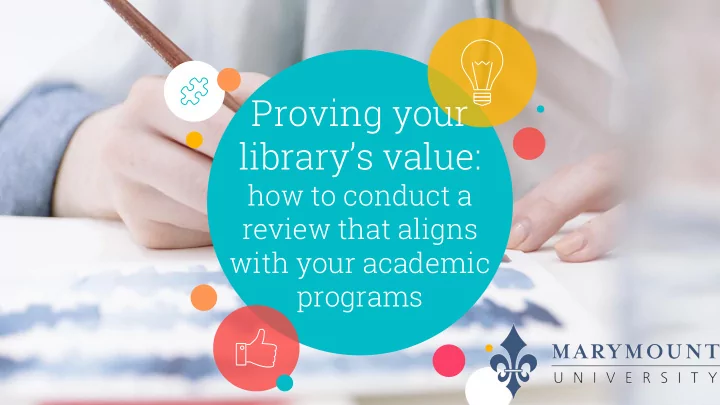

Proving your library’s value: how to conduct a review that aligns with your academic programs
Hello from Marymount University!
Introduction
Overview of Marymount University ○ ○ ○ ○
Setting the scene ○ ○ ○ ◦ ◦ ◦ ◦ ◦ ○
Overview of the review ○ ○ ○ ○ ○ ○ ○ ○ ○
Project Timeline ● Receive External Reviewer report ● Start developing the Action ● Work on background: ● Feedback from APBP Plan components 1-4 ● Action Plan completed February - April June October January May August ● Form teams ● Draft report sent to PIE ● Submit Final Report to APBP ● Create project plan ● Report sent to external reviewer ● Initial team meetings ● External reviewer visit
COMPONENT 1:
Assessment & Effectiveness
University goals Task 1: What are the library’s outcomes? Academic Affairs Library & Learning Services
Spaces that support the needs of students Sample outcome Space improvements on campus Library’s physical space
○ Task 2: How does the library assess ○ achievement of these outcomes? ○
COMPONENT 2:
Resource Allocation and Use
○ ○ Task 1: Personnel ○ ○
○ Task 2: Facilities ○
○ Task 3: Budget ◦ ◦ ◦ ○
COMPONENT 3:
Benchmarking
Using Marymount’s Benchmark Peer or ○ Task 1: Aspirational School Lists, identify at least three Determine institutions with similar libraries universities for benchmarking If there are accrediting and/or professional ○ standards that guide the library’s operations, the library may use them as one of the comparisons
Benchmarked libraries needed to have MU’s similar: Mission & Vision ○ Who looked like Values ○ us? Goals ○ Our Dean emphasized attributes such as: belonging to a library consortium ○ proximity to a major city ○ librarians classified as faculty ○ that she wanted our team to include in our analysis.
Thanks to our Office of Planning & Institutional Effectiveness: How did we chose libraries to benchmark against? Step 1: Step 2:
Conduct a benchmarking analysis of the identified ○ Task 2: institutions. Benchmarking analysis Use the benchmarking summary sheet to record your ○ findings
ACRL Metrics Data IPEDS Data Step 3: Used 262 criteria items from ACRL Metrics to narrow down to 4 universities due to missing or not applicable survey data from the other libraries. Then we added IPEDS Data to the analysis.
Step 3a: ○ ○ ○ ○ ○ ○ ○ ○ ○
Briefly explain why the institution was List names of people chosen. interviewed, websites Mission and scope of Complete Benchmark and any other work (University Summary Sheet information . mission statements) Benchmarking Part A Summary Report Part A Library Components Mission and Contact Info at Vision chosen libraries What similarities or Statements Educational support differences exist by library faculty between (only MU has library Marymount’s library faculty status) operations and the institution’s?
Use the benchmarking summary sheet to record your findings. Benchmarking The purpose of the summary is to answer the following Summary Sheet questions: Part B 1. How do the library’s mission and scope of work compare to other schools? (Shown as Part A) 2. Is the library in sync with current trends and best practices in the field? 3. What is unique about Marymount’s library? 4. Based on the findings, what changes (additions or modifications) should the library consider? (This information was folded into a later section)
Task 2.2: % budget allocation for collections ○ Is the library in Budget shift from print monographs to other ○ sync with Collection budget shift from traditional to PDA ○ current trends Collection budget purchases ○ and best Open Education Initiatives ○ practices in the Institutional Repository field? ○ Digitized institutional documents ○ Digitize print resources ○ Support for creating digital collections ○ Shared print collection ○ ACRL Trends Report Source: Association of College and Research Libraries. (2015). Summary Data Tables- ACRL 2015. Retrieved from http://www.acrlmetrics.com/main.php?page_id=13
We are doing GREAT!
○ Task 2.3: What ○ is unique about ○ MU’s library? ○ ○ ○
A y t i s r e v i n U University B Marymount University University C
COMPONENT 4:
Constituent input
University-wide surveys Graduating MAYS Student MAYS Faculty Alumni Task 1: Review student data from institutional surveys Library surveys Mystery Student Faculty LI evaluations shopper satisfaction satisfaction
Task 2: Gather input from students and/or There was sufficient data from all patron groups. other No additional data was required to assess the constituents effectiveness of the library.
Identify major themes regarding library ○ Task 3: Identify strengths and areas for improvement. major themes Themes should inform the external ○ reviewers’ discussion with students and the programs action planning. Are there things that our constituency group ○ needs or wants that we’re not doing?
Major themes ○ ○ ○ ○
COMPONENT 5:
External reviewer ○ ○ ○ ○
Task 1: In consultation with Dean’s responsibility the vice president, ○ identify a candidate to serve ○ as an external reviewer. ○
Task 2: Coordinate ○ the reviewer’s ◦ documentation ◦ and site visit, if ◦ required. ◦ ◦ ◦ ◦
Placement in the Collections Programs institution Summary of external reviewer report Staffing Organization Space within LLS
Task 3: Response to external reviewer’s report
Placement in the Collections Programs institution Response to external reviewer report Space Organization Staffing within LLS Required more explanation Disagreed with the reasons for turn over
COMPONENT 6:
Developing an action plan ○
Task 1: Summarize the library’s engagement ○ and contributions ○
Task 2: Develop a five-year action plan
Task 2: Develop a five-year action plan
○ Submitting the report ○
Next Steps
Lessons learned ○ ○ ○ ○ ○
Thanks!
Recommend
More recommend